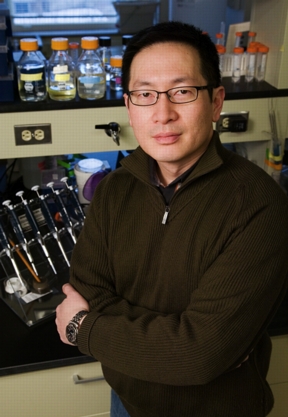Home > Press > Scientists decipher mechanism behind antimicrobial 'hole punchers'
 |
| Photo by L. Brian Stauffer
The rapid development of bacterial resistance to conventional antibiotics has become a major public health concern. Gerard Wong, an Illinois professor, and colleagues at the University of Massachusetts have made a discovery that could shorten the road to new and more potent antibiotics. |
Abstract:
In the battle against bacteria, researchers have scored a direct hit. They have made a discovery that could shorten the road to new and more potent antibiotics.
Scientists decipher mechanism behind antimicrobial 'hole punchers'
CHAMPAIGN, IL | Posted on September 20th, 2007The rapid development of bacterial resistance to conventional antibiotics (such as penicillin or vancomycin) has become a major public health concern. Because resistant strains of bacteria can arise faster than drug companies can create antibiotics, understanding how these molecules function could help companies narrow their focus on potential antibiotics and bring them to market sooner.
As reported in a paper accepted for publication in the Journal of the American Chemical Society and posted on its Web site, researchers have now deciphered the molecular mechanism behind selective antimicrobial activity for a prototypical class of synthetic compounds.
The compounds, which mimic antimicrobial peptides found in biological immune systems, "function as molecular ‘hole punchers,' punching holes in the membranes of bacteria," said Gerard Wong, a professor of materials science and engineering, physics, and bioengineering at the U. of I., and a corresponding author of the paper. "It's a little like shooting them with a hail of nanometer-sized bullets - the perforated membranes leak and the bacteria consequently die."
The researchers also determined why some compounds punch holes only in bacteria, while others kill everything within reach, including human cells.
"We can use this as a kind of Rosetta stone to decipher the mechanisms of much more complicated antimicrobial molecules," said Wong, who also is a researcher at the university's Beckman Institute.
"If we can understand the design rules of how these molecules work, then we can assemble an arsenal of killer molecules with small variations, and no longer worry about antimicrobial resistance."
In a collaboration between the U. of I. and the University of Massachusetts at Amherst, the researchers first synthesized a prototypical class of antimicrobial compounds, then used synchrotron small-angle X-ray scattering to examine the structures made by the synthetic compounds and cell membranes.
Composed of variously shaped lipids, including some that resemble traffic cones, the cell membrane regulates the passage of materials in and out of the cell. In the presence of the researchers' antimicrobial molecules, the cone-shaped lipids gather together and curl into barrel-shaped openings that puncture the membrane. Cell death soon follows.
The effectiveness of an antimicrobial molecule depends on both the concentration of cone-shaped lipids in the cell membrane, and on the shape of the antimicrobial molecule, Wong said. For example, by slightly changing their synthetic molecule's length, the researchers created antimicrobial molecules that would either kill nothing, kill only bacteria, or kill everything within reach.
"By understanding how these molecules kill bacteria, and how we can prevent them from harming human cells, we can provide a more direct and rational route for the design of future antibiotics," Wong said.
This work was supported by the National Science Foundation, the National Institutes of Health and the Office of Naval Research.
####
About University of Illinois
At Illinois, research shapes the campus identity, stimulates classroom instruction and serves as a springboard for public engagement activities throughout the world. Opportunities abound for graduate students to develop independent projects and launch their own careers as researchers while working alongside faculty and assisting in their research. Illinois continues its long tradition of groundbreaking accomplishments with remarkable new discoveries and achievements that inspire and enrich the lives of people around the world.
For more information, please click here
Contacts:
James E. Kloeppel
Physical Sciences Editor
217-244-1073
Gerard Wong
217-265-5254
Copyright © University of Illinois
If you have a comment, please Contact us.Issuers of news releases, not 7th Wave, Inc. or Nanotechnology Now, are solely responsible for the accuracy of the content.
| Related News Press |
Nanomedicine
![]() New micromaterial releases nanoparticles that selectively destroy cancer cells April 5th, 2024
New micromaterial releases nanoparticles that selectively destroy cancer cells April 5th, 2024
![]() Good as gold - improving infectious disease testing with gold nanoparticles April 5th, 2024
Good as gold - improving infectious disease testing with gold nanoparticles April 5th, 2024
![]() Researchers develop artificial building blocks of life March 8th, 2024
Researchers develop artificial building blocks of life March 8th, 2024
Announcements
![]() NRL charters Navy’s quantum inertial navigation path to reduce drift April 5th, 2024
NRL charters Navy’s quantum inertial navigation path to reduce drift April 5th, 2024
![]() Discovery points path to flash-like memory for storing qubits: Rice find could hasten development of nonvolatile quantum memory April 5th, 2024
Discovery points path to flash-like memory for storing qubits: Rice find could hasten development of nonvolatile quantum memory April 5th, 2024
|
|
||
|
|
||
| The latest news from around the world, FREE | ||
|
|
||
|
|
||
| Premium Products | ||
|
|
||
|
Only the news you want to read!
Learn More |
||
|
|
||
|
Full-service, expert consulting
Learn More |
||
|
|
||








